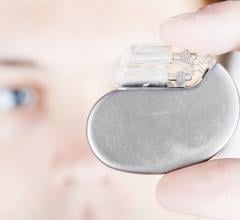
August 2, 2012 — The Heart Rhythm Society (HRS) and the American College of Cardiology Foundation (ACCF) has released the HRS/ACCF Expert Consensus Statement on Pacemaker Device and Mode Selection. The expert consensus statement was developed in collaboration with the Society of Thoracic Surgeons (STS), endorsed by the American Heart Association (AHA) and published online as part of the August edition of HeartRhythm, the official journal of the Heart Rhythm Society, as well as the Journal of the American College of Cardiology (JACC). The statement is the first of its kind to specifically address pacemaker device and mode selection, expanding upon the ACC/AHA/HRS 2008 guidelines for device-based therapy of cardiac rhythm abnormalities.
The new statement provides a review of the field and reports consensus recommendations on pacemaker device and mode selection. It is a guide to facilitate the appropriate use of single- versus dual-chamber devices for patients who already meet guidelines for pacemaker implantation when a clinical decision for pacing has been made. It includes recommendations for conditions for which there is evidence or general agreement that a given pacing mode is beneficial, useful and effective. This includes conditions for which there is conflicting evidence about the usefulness of a specific pacing mode.
Approximately 400,000 devices are implanted each year in the United States, and there are currently more than three million patients with implanted cardiac devices.[1] Over the past 15 years, multiple randomized trials have compared a number of cardiovascular outcomes among patients randomized to atrial or dual-chamber pacing versus those randomized to ventricular pacing, showing an unmet need for uniform recommendations.
“As new clinical data emerges and technology advances, it is important that clinicians and researchers collaborate to update our knowledge and ensure the best quality of care is delivered,” said co-lead author of the statement, Anne M. Gillis, M.D., FHRS, president of HRS. “This document represents the first recommendations specific to pacing devices and mode selection for the individual patient and provides a framework for clinicians and healthcare administrators to select the best possible therapy to optimize patient outcomes.”
HRS and ACCF convened a panel of 11 cardiac electrophysiologists and surgeons from the United States, Canada and Europe. The writing group reviewed outcomes of pacing mode selection for patients with sinus node dysfunction (SND), atrioventricular (AV) conduction block and other less common indications for pacing. The specific recommendations were based on data derived from multiple randomized clinical trials, single randomized trials, nonrandomized trials, case studies, as well as the expert opinions of the writing group.
Collectively, the consensus experts recommend patients with SND may benefit from atrial or dual-chamber pacing compared with ventricular pacing in regards to the risks of atrial fibrillation (AF), stroke, pacemaker syndrome and improved quality of life. In patients with AV block, dual-chamber pacing can reduce the incidence of pacemaker syndrome and improve some indexes of quality of life. Furthermore, recommending dual chamber pacing or single chamber atrial pacing should not be used in patients in permanent or longstanding persistent AF. Specific recommendations for cardiac resynchronization therapy are not addressed in this document as they are currently provided in previously published guidelines.
For more information: www.heartrhythmjournal.com
References:
1. American Heart Association, “Cardiology Patient Page, Pacemaker and Defibrillator Lead Extraction” (Circulation 2011; 123: e378-e380), E. Buch, MD. http://circ.ahajournals.org/content/123/11/e378.full


 May 02, 2025
May 02, 2025 









